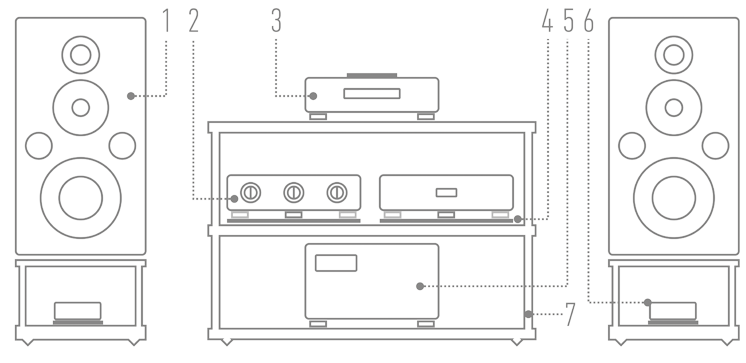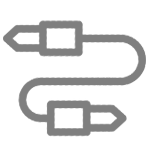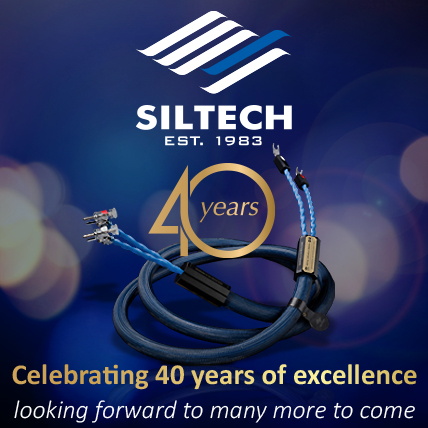|
LINESTAGE • passive Phasemation
Manufacturer: |

|
Review
Text by WOJCIECH PACUŁA |

|
No 241 June 1, 2024 |
PHASEMATION SAYS ABOUT ITS NEW PRODUCT: "it is a hybrid passive attenuator with balanced inputs and outputs and an innovative volume control mechanism that is now even better than before (...)". This explanation is important insofar as we are talking about a product that we are used to calling a "preamplifier," and whose primary function is signal attenuation. 
It is most often referred to as "passive preamplifier," which is an oxymoron that refers directly to Baroque literature ("hot ice", "dark star", etc.). However, it is used often enough to serve a similar role as another modern oxymoron, "virtual reality". That is, we know it's a contradiction in terms, yet we use it because of its usefulness. The latest preamplifier - for I will use that name - by Phasemation is therefore a passive device that does not need any power supply. The manufacturer itself realizes this by placing it in a subgroup called Controller. It replaces the earlier CM-2000 model in the range, offering, however, some, quite significant changes, primarily new transformers. ▌ CM-2200 THERE ARE TWO PIECES of information encoded in Phasemation's device name. The most important is the type of device and its status. 'CM' is short for 'Control Meister. Japan's fascination with Prussia, with its technological superiority from the turn of the 20th century resurfaces from time to time, including today. In doing so, they readily reach for the associated nomenclature, unlike most of the world, which cultivates terminology of English origin. For example, Mr. Okihiko Sugano, a brilliant Japanese mixing engineer, named his last-ever label Audio Meister, inspired by the German-language term used to describe a sound engineer, which is Tonmeister (more → HERE), also used in the name of the Berliner Meister Schallplatten label (more → HERE). Control Meister would thus be a reference to this, somewhat nostalgic, trend. The "2000" series, on the other hand, to which it belongs, is the second from the top line of this company. It features the MA-2000 amplifier, the T-2000 step-up transformer, the PP-2000 phono cartridge and the EA-2000 phono preamplifier, consisting of six (!) separate modules. Above that is another series, the "5000," but currently with only two products: the MA-5000 amplifier and the PP-5000 cartridge. The CM-2200 is the only preamplifier in Phasemation's lineup at the moment. The company says about its new product:
As far as functionality goes, the Control Meister CM-2200 is a device we are familiar with. It is a preamplifier, plugged in between the sound source and the power amplifier. Its primary role is to adjust the volume, or attenuate the signal. But not only that, it's also the hub we connect all the signal sources we have to, and where we choose which one is active. There is a large, convenient knob for adjusting the volume, and two smaller ones input and output selection. The unit looks superb, as Japanese products do. Its appearance is determined by its gold anodized finish - a similar shade to Accuphase's devices - with aluminum components on the outside and a wooden ones underside. This combination is supposed to help with controlled vibration damping. We are familiar with wood used in this way, for example, from SPEC equipment (more → HERE). Here, however, the feet are not made of wood, but metal. They were bought from another Japanese specialist, TAOC, which makes them using high-carbon steel. Which, again, is reminiscent of Accuphase's efforts. 
All these solutions in the CM-2200 serve not only to control vibration, but also to shield the components inside. The chassis is weighted down with a 2mm steel plate on the bottom. The top panel and sides have been additionally clad with a mu-metal-like material, which reminds me of a technique once used by Arcam. In the case of that British manufacturer, it was a material called Sontech, originally invented for racing cars. It was a sandwich composed of two thick sheets of steel or aluminum of variable thickness, bonded by an elastic substance (a company patent). And there is another level of vibration damping, namely decoupling of transformers. Phasemation says about it:
It has already been said several times, so it's high time to clarify: the basis of signal attenuation in the CM-2200 is transformers with switched taps. This is a well-known and frequently used idea, for example, by the Polish company → VINIUS AUDIO. For the sake of argument, let's also say that my Ayon Audio Spheris III preamplifier too is based on transformers, but with an active stage. | Analog attenuators THE BASIC ROLE OF A PREAMPLIFIER is, contrary to appearances, signal attenuation. That's why many manufacturers equip their CD players, file players, etc. with a volume control, saying that it's a "player with a preamplifier". This is usually not true, as the DIN standard states that the CD output signal is to be 2 V, and higher voltages are usually required to drive a power amplifier. Habit, however, cannot be fought. 
⸜ Attenuator built with resistors and solid-state switches in TotalDAC D1-UNITY D/A converter This type of attenuator - we will focus only on analog ones - may have a various types of design. In its simplest form, it is a RESISTANT POTENTIOMETER, familiar from most amplifiers and preamplifiers. But the potentiometers themselves can also be of different classes. The most common are basic versions of potentiometers made by the Japanese company ALPS, black and blue, sometimes also malachite. But there are also outstanding examples, as in Octave Audio's Jubilee Pre preamplifier in a previous version, where it was a component from another Japanese company, TKD (Tokyo Ko-On Denko, more → HERE). 
⸜ SPEC RSA-V10 amplifier chip attenuator Companies with an audiophile pedigree often use RESISTOR LADDERS with mechanical switch, relays or with semiconductors as switches. This is how Cambridge Audio made its more expensive devices (relays), or → TOTALDAC (semiconductors). Another common choice is SCALED RESISTOR LADDERS, digitally controlled but analog. These are circuits originally used in professional equipment, but quickly adapted to "home audio" circuits. Examples include amplifiers from SPEC or Musical Fidelity. 
⸜ Attenuator with relay-switched transformers in Phasemation CA-1000 preamplifier Phasemation used both a TRANSFORMER with multiple taps and a RESISTANCE LADDER, or hybrid circuit, as an attenuator. However, in previous preamplifiers like the CA-1000, they used only relay-switched transformers (more → HERE ˻ PL ˺). Reed switches the windings of Ayon Audio's Spheris III preamplifier, and - already mentioned - Vinius Audio with a switch. 
⸜ A hybrid attenuator in CM-2200 But there are still other, ACTIVE circuits. For example, Accuphase's AVAA (Accuphase Analog Vari-gain Amplifier). Instead of attenuating the signal, which involves a constant change in input and output impedance, it uses a current regulating circuit. Since the audio signal transmitted between devices is in voltage form, the circuit converts the signal to current at the input and to voltage at the output. Example: the C-3900 preamplifier, more → HERE. ● |
PHASEMATION's IDEA OF VOLUME CONTROL is a bit different than most of the cited manufacturers. It's a passive attenuator. However, in order to increase the range of regulation, without complicating the transformer design, we have a hybrid circuit - transfomator-resistor. This is a circuit in which several attenuation steps are installed between successive transformer taps on resistors that are changed in a large switch. The signal path is balanced in it. But there is more. The CM-2200 uses new transformers with sheets of, as we read, "extremely small cross-section" (0.1 mm) and high-purity copper winding wire. This is a copper called PC-Triple C, made only in Japan, and introduced to audio on a larger scale by Acoustic Revive (more → HERE). The transformers work in such a way that the device can amplify the signal, up to +6 dB. On the rear panel there is a switch with which one selects whether the circuit works from 0 to -70 dB or from +6 to -64 dB. The company assures that this is "the world's only such preamplifier". The workmanship of the device is excellent. The sockets are of equally high quality as the manufacturer chose rhodium-plated sockets from Furutech. There is also a terminal for external grounding. And one more thing, also important: the device does not feature a remote control. Which, to be honest, is quite tiresome. ▌ SOUND HOW WE LISTENED • The CM-2200 preamplifier stood on the top shelf of a Finite Elemente Master Reference Pagode Edition MkII rack on its feet. It was connected to the Ayon Audio CD-34 HF Edition SACD player by a Siltech Triple Crown interconnect, and to the Soulution 710 power amplifier by an Acrolink 8N-A2080III EVO interconnect. The unit was compared to the active tube preamplifier Ayon Audio Spheris III in AA/BB/A listening, with known A and B. 
During the test, I also used the ground terminal of the CM-2200, to which I connected a Nordost QKORE 6 artificial ground (more → HERE). » PŁYTY UŻYTE W TEŚCIE ⸜ wybór
⸜ T. HONDA + MAMA T., Misty, Trio Records/Ultra-Vybe UVWA0042 | Solid Records (6) CDSOL1483, „Nippon Jazz Spirits” No. 41, CD (1972/2020). ONE THING I don't like about passive preamplifiers is the lack of "action", so to speak. They sound, to me, dull and faded. This is not always the case, but that’s how I remember most of them. This "fading" is about the loss of energy that is "sewn" into the music, not that active preamplifiers "pump up" the sound - because they don't. Transformer-based preamps, however, are different. And the CM-2200 is even more "different". 
Above all, it does not diminish dynamics. Recorded live in 1972 under not very favorable conditions, as it was recorded at the American Yokota Air Base (Japan), the album by TAKEHIRO HONDA and American soul singer MAMA T is not the pinnacle of technical capabilities. Although the drums and piano sound very cool, the vocals have a very narrow bandwidth, sometimes you can't hear them, sometimes they are too quiet, etc. But the music - it „rocks”. And just this, just this „rocking” was maintained, sustained and shown by the Phasemation preamplifier. So the CM-2200 plays dynamically, that's one thing. It also plays sweetly, if I may say so. The vocals are heavily distorted in this recording, but somehow it didn't bother me. The way of singing, the energy and emotion are perhaps even more vibrant in it. The tested preamplifier slightly smoothed out these roughnesses, made them a little more pleasant. But without extinguishing dynamics or expression. The brass in the left channel still hit hard and was resonant, and the leader piano in the right channel was clear and intelligible. The vocals were approximated, and I'll come back to that in a moment, but also had a remarkably pleasant timbre. And it was the timbres that captivated me so much while listening to music with Mr. Nobuyuki Suzuki's preamplifier. When I played the opening track of SHABAKI's first solo album ˻ 1 ˺ End of Innocence, with its gorgeous sound, recorded at Van Gelder Studios by Maureen Sickler, it was the leader's fantastic clarinet that was shown up close, almost intimately. But not all the time, for I could hear that during playing he was moving away, then closer to the microphone. And this shows that the preamp differentiates spatial relationships, dynamics and size of sound sources very well. Such nice, pleasing, complete timbres were due to the device's very even reproduction of the entire bandwidth. Cymbals here were strong and dense, even heavy, but never bright. The CM-2200 sweetens the sound, no doubt about it. However, it does it sensitively and without rounding off the attack. That's why both Mama T previously and the brass instruments played by Hutchings had a distinct character, even though their texture was silky and their attack sweet. I use this "sweetness" for a reason. After listening to music with this device you’re left with this sweetness. This is not a device that attacks or "dissects" the sound to its essentials. On the contrary. It behaves like a thoroughbred active preamplifier. It shows large phantom images with well-defined contours and bodies. But it does so without clearly separating sounds. It may even mix them together, creating a dense "carpet". The reference preamp is less silky without being darker. And comparisons between it and other devices usually show the opposite. Phasemation is an unusual preamplifier against this background. For it does not sound like a passive device. It is closer to what I know from listening to Kondo and Audio Note devices. Its sound is dense and low. Warm, but also resolving. Silky, yet legible. What seems important is that it doesn't make the sound shallow, that it doesn't slim it down. The bass in ˻ 3 ˺ Caramel, a track from SUZANNE VEGA's album entitled Nine Objects of Desire, I knew this was it. The CM-2200 brought all the sounds together and let it all roll. The sound was less selective than with the Ayon, and didn't have as much breath. But instead I got an intimate, close presentation, wonderfully recorded by Tchad Blake. This advocate of analog recording techniques, an experimenter - to recall the Binaural album by Pearl Jam - recorded the drums and percussion on this track in a soft, warm way. The Japanese preamplifier showed this perfectly, same as the guitar set far into the scene in the ˻ 12 ˺ My Favourite Plum track closing the album. Recorded at Abbey Road, the strings, shown here for a while in the left channel, had nice textures and were big and dense. They weren't particularly resolving, but that's probably not what this album was about. The beautiful sound of the electric organ in the first minute was as close as Shabaki's clarinet, which is to say, it was on point. And all this basking in a warm, golden glow. And then there was the thump of the big drum (kick drum)! It was brilliant in its presence and extension. Let me tell you something that should not be said to audiophiles: CM-2200 will improve your listening experience, even though in direct comparison with the Spheris III preamplifier its sound will not be so "linear". This, to me, is an unprecedented thing, since almost all my previous experience with passive devices says the exact opposite. The Phasemation serves up sound in an extremely pleasant, even comfortable way, adding weight and scale to it. Like with the Secret Treasures album by the Blue Öyster Cult. Recorded in 1974 at Columbia's 30th Street Studios, that by an idiotic decision was demolished in the early 1980s, it sounds quite light. Even the Audio Fidelity label's 2016 remastering by Steve Hoffman and Stephen Marsh for SACD doesn't correct this. The tested preamplifier corrected it slightly. In the sense that I could "hear" the lack of lower bass, it was clear that the tonal balance was shifted upward. And yet the listening experience was incredibly pleasant. Listening to the album's opening ˻ 1 ˺ Career of Evil, to which Patty Smith wrote the lyrics, I heard both proper expression - this is, after all, a hard rock band - there were cool harmonies, there were "conversations" between the guitars with their solos, and the drums didn't stand out. And it was still, after all, compressed, powerful music with the distortion and "emphasis" that people seeking strong sensations were echoing in the 1970s. This ability to show the character of the recordings, while sweetening and bringing the foreground even better came out with electronic music, so by definition clean and selective. I would even say that it was with it that the CM-2200 sounded remarkably good. Because it was strong, dense, and low. Even the rather brightly recorded 1 ˺ Misarebilism by the PET SHOP BOYS had a great, sweet timbre and "presence". This, I might add, is the track featured on the 3" CD single accompanying the special edition of the Behaviour album, released in Japan by Toshiba EMI. ▌ Summary IT SHOULD BE CLEAR: the Phasemation CM-2200 preamplifier plays like a thoroughbred active preamplifier, and maybe even better. It preserves the dynamics of recordings, deepens the bass, and slightly sweetens the treble. It is resolving, but not overly selective. I won't be too wrong if I say that it's a very good compromise between what's in the recording and what should be there for a good listen. That's why this device is so different from the vast majority of passive preamplifiers. It does not dry out, but saturates the sound, does not reduce dynamics, but refines them. By the way, I will say that I liked to listen best with the gain switch at the +6 position. It shouldn't matter, since the volume knob was somewhere in the middle of the scale anyway, but it seemed to me that the sound was then more intimate, more saturated. 
I think this is the first time all this has been brought together in such a nice way, so pleasing. The Japanese preamplifier perfectly "feels" the recordings, their character and drama. Its sound is sweet, intimate and dynamic. It is not as selective or as resolving as the Ayon Audio Spheris III. But in return, it gives a much nicer perspective to recordings with not-quite-good sound, and polishes those with good to excellent sound beyond measure. I can't help but award it ˻ GOLD FINGERPRINT ˺, our most important award, emphasizing the top-high-end class of the device. ● ▌ Technical specifications (according to the manufacturer)
Type: hybrid passive attenuator 
THIS TEST HAS BEEN DESIGNED ACCORDING TO THE GUIDELINES adopted by the Association of International Audiophile Publications, an international audio press association concerned with ethical and professional standards in our industry, of which HIGH FIDELITY is a founding member. More about the association and its constituent titles → HERE. |

|
Reference system 2024 |
|
 1) Loudspeakers: HARBETH M40.1 |REVIEW| 2) Line preamplifier: AYON AUDIO Spheris III Linestage |REVIEW| 3) Super Audio CD Player: AYON AUDIO CD-35 HF Edition No. 01/50 |REVIEW| 4) Stands (loudspeakers): ACOUSTIC REVIVE (custom) |ABOUT| 5) Power amplifier: SOULUTION 710 6) Loudspeaker filter: SPEC REAL-SOUND PROCESSOR RSP-AZ9EX (prototype) |REVIEW| 7) Hi-Fi rack: FINITE ELEMENTE Pagode Edition |ABOUT| |
|

|
Cables Analog interconnect SACD Player - Line preamplifier: SILTECH Triple Crown (1 m) |ABOUT|Analog interconnect Line preamplifier - Power amplifier: ACOUSTIC REVIVE RCA-1.0 Absolute-FM (1 m) |REVIEW| Speaker cable: SILTECH Triple Crown (2.5 m) |ABOUT| |

|
AC Power Power cable | Mains Power Distribution Block - SACD Player: SILTECH Triple CrownPower (2 m) |ARTICLE| Power cable | Mains Power Distribution Block - Line preamplifier - ACOUSTIC REVIVE Power Reference Triple-C (2 m) |REVIEW| Power cable | Mains Power Distribution Block - Power amplifier - ACROLINK Mexcel 7N-PC9500 |ARTICLE| Power cable | Power Receptacle - Mains Power Distribution Block: ACROLINK Mexcel 7N-PC9500 (2 m) |ARTICLE| Power Receptacle: Acoustic Revive RTP-4eu ULTIMATE |REVIEW| Anti-vibration platform under Acoustic Revive RTP-4eu ULTIMATE: Asura QUALITY RECOVERY SYSTEM Level 1 |REVIEW| Power Supply Conditioner: Acoustic Revive RPC-1 |REVIEW| Power Supply Conditioner: Acoustic Revive RAS-14 Triple-C |REVIEW| Passive filter EMI/RFI: VERICTUM Block |REVIEW| |

|
Anti-vibration Speaker stands: ACOUSTIC REVIVE (custom)Hi-Fi rack: FINITE ELEMENTE Pagode Edition |ABOUT| Anti-vibration platforms: ACOUSTIC REVIVE RAF-48H |ARTICLE| Isolators: |

|
Analogue Phono preamplifier: Phono cartridges:
Clamp: PATHE WINGS Titanium PW-Ti 770 | Limited Edition Record mats:
|

|
Headphones Headphone amplifier: AYON AUDIO HA-3 |REVIEW|Headphones: Headphone Cables: Forza AudioWorks NOIR HYBRID HPC |
main page | archive | contact | kts
© 2009 HighFidelity, design by PikselStudio,
projektowanie stron www: Indecity






 Several years ago we released the highest grade hybrid passive attenuator [Control Meister CM-2000] that does not contain an active circuit and is distinct from the previous preamplifiers.
Several years ago we released the highest grade hybrid passive attenuator [Control Meister CM-2000] that does not contain an active circuit and is distinct from the previous preamplifiers.















